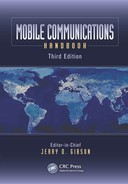Preface
This third edition of the Mobile Communications Handbook reflects the extraordinary evolution of wireless communications and networks over the last 15 years, with 5 extensively revised chapters and 26 entirely new chapters out of a total of 39 chapters. We use the term mobile communications to include technologies ranging from digital cellular mobile radio and evolving personal communication systems to wireless data and wireless networks. This range of topics is presented in 39 concise chapters authored by experts from industry and academia. The chapters are written to provide a succinct overview of each topic, quickly bringing the reader up to date, but with sufficient detail and references to enable deeper investigations. The chapters are more than a “just the facts” presentation, with the authors using their experience in the field to provide insights into how each topic has emerged and to point toward forthcoming developments in mobile communications.
This book is divided into five sections: Basic Principles, Wireless Standards, Source Compression and Quality Assessment, Wireless Networks, and Emerging Applications. The chapters in the Basic Principles section provide the essential underpinnings for the wide-ranging mobile communication technologies currently in use throughout the world. The section on Wireless Standards contains technical details of the standards we use every day, and the chapters give insights into the development of the several standards. The third section covers the compression techniques used to represent voice and video for transmission over mobile communications systems as well as how the delivered voice and video quality are assessed. The Wireless Networks section examines the wide range of current and developing wireless networks and wireless methodologies all the way through the newly developed areas of vehicular communications and 60 GHz wireless communications.
The Basic Principles chapters readily allow the reader to jump right to the mobile communications topic of interest, with the option of efficiently filling in any gaps in one's background by referring back to the Basic Principles section as needed, without flipping through a textbook or searching the Internet.
Although there is an ordering to the chapters, the sequence does not have to be read from the beginning to the end. Each chapter was written to be an independent contribution with intentional overlap between some chapters to show how the many topics interconnect. Interestingly, as the reader will discover, this overlap often admits alternative views of difficult issues.
It has been a great pleasure to work with the authors to publish this third edition. The authors come from all parts of the world and constitute a literal who's who of workers in digital and mobile communications. Certainly, each article is an extraordinary contribution to the communications and networking fields, and the collection, I believe, is the most comprehensive treatment of the mobile communication field available in one volume today.
I appreciate the patience, support, and guidance of the staff at CRC Press/Taylor & Francis, particularly Nora Konopka, and the energetic and responsive assistance of Ashley Gasque during all stages of developing and producing this handbook.
Jerry D. Gibson
Santa Barbara, California
MATLAB® is a registered trademark of The MathWorks, Inc. For product information, please contact:
The MathWorks, Inc.
3 Apple Hill Drive
Natick, MA 01760-2098 USA
Tel: 508 647 7000
Fax: 508-647-7001
E-mail: [email protected]
Web: www.mathworks.com
